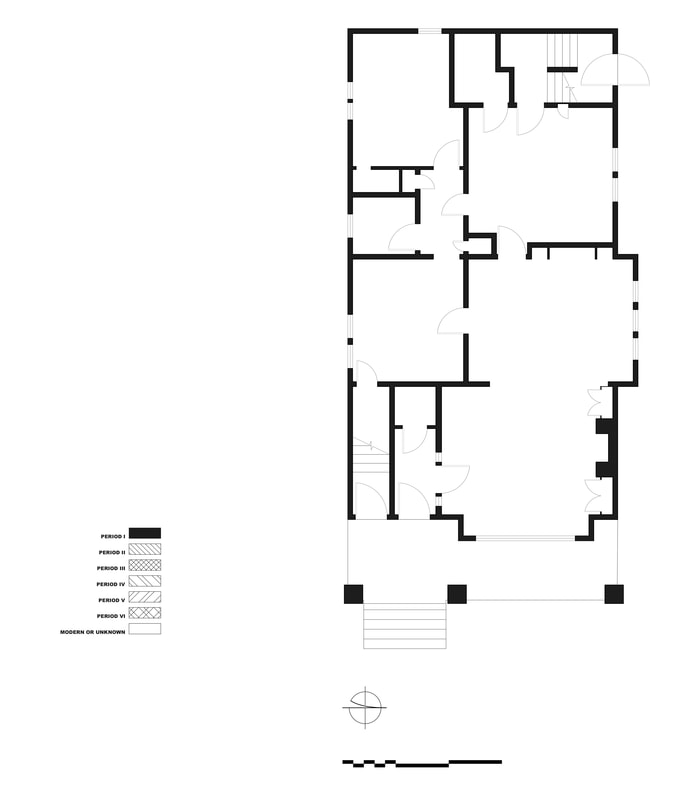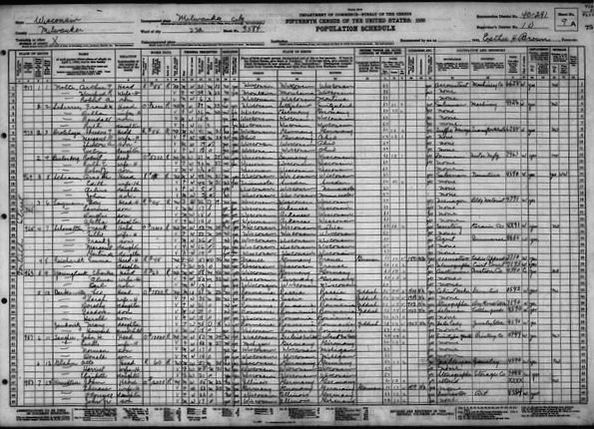A Corner DuplexTeonna N. Cooksey
Located on the corner plot of a quiet residential block in Sherman Park, perched on a small grassy knoll, is a beautiful home, painted pale green with black trim. The shrubs encircling the front porch provide the perfect amount of privacy, yet, they’re just stubby enough to give an open feel to the home. Bright red, pink, orange, and yellow flowers are sparsely placed around the front yard, creating a contrast to the exterior façade. An American flag is suspended from the balcony, directly above a wind chime that dangles on the thick wooden beam of the porch. The residence marks the block with quiet dignity. Built on June 15, 1922, this duplex represents a common building type found throughout the Sherman Park neighborhood. Duplex homes were commonly built throughout working and middle-class communities in Milwaukee prior to 1930. These buildings typically consist of a first-floor plan that is two rooms wide and two-three rooms deep. The first-floor plan is replicated onto the second floor. The building under examination follows these standard layout patterns: the front porch stretches the entire width of the front façade. The living, dinning, and kitchen spaces are aligned on one side of the floor plan. The bedrooms and bathrooms are aligned on the other. This arrangement is common to the house type, which was particularly innovative in its time. According to Thomas Hubka, the duplex bungalow is one of the first plan types to include electricity, a three-fixture bath, and an “open plan” with the living and dining spaces connected without a wall in-between.[1] The front-back layout also creates a unique back yard space connected to the garage. The garage in this building was modified to fit a larger sized car in later years. Unlike mid-block buildings, where the back stairs open into a back yard, the back staircase in this building opens out into the sidewalk directly. The first owner of the home, Frank Derolla, decided to build this two-story flat. The cost was $6,000 for the initial house, and the garage was added a mere five days later. Built on a 40 x 120 feet lot of land with two-by-four studding and veneer siding, this home has barely had any major modifications done to its original structure. In October of 1936, Frank Scherrer, a machinery salesman, purchased the home from Frank Derolla at a price of $1,255. Frank Scherrer lived in the lower level of the duplex with his wife, Della, and two children. The parents of Frank and Della were from Switzerland and Germany respectively. The upper apartment was occupied by Arthur Nolte, an accountant, his wife, and son. Everyone living in both levels of the duplex were white, per census data, and they were all from Wisconsin. The men in both the upper and lower levels of the house worked, but neither of their wives did. In 1963, B.J Spurs owned the home, and he requested a permit to add an additional accessory building to the garage. The permit was approved, but Spurs had to pay $200 for collar beams to be built. Mrs. Schultz owned the home in 1968 and requested an electrical installation permit to install a new furnace. By April of 1973, there was a change in ownership to John Stokes, who initiated a lot more work on the home than most previous owners. Major changes include heating and electrical installations, and a remodeling of the exterior siding in March 1976. Stokes had work done on the drains, updated the electrical work and furnace, created a recreation room in the basement, and applied siding to the exterior and changed the downspouts. Today, the interior spaces are adapted and used in ways other than originally intended. In the twentieth century, the front rooms, such as the parlor, living, and dining areas, were used for socializing and entertaining. The back section of the home included bedrooms, kitchen, back stairs and basement. These spaces were marked and separated from the front section by doors and walls, or marked off by differences in ornamentation or woodwork. The current owner didn’t think this type of separation was necessary, so she removed the door that leads to the kitchen. That action represents a changing culture of how domestic spaces are used and interpreted. By transforming the conventions demarcating public/private spaces, the current owner displays how culture, use, and lifestyle changes over time. The current plan-layout is now more open and inviting; the hierarchy and sequence of rooms, from the formal public space to the utilitarian private space, is now reformatted to suit contemporary needs. [1] Thomas Hubka, Houses without Names: Architectural Nomenclature and the Classification of America's Common Houses, (Knoxville: University of Tennessee Press, 2013), p. 57. |
Permits Records:
Veneered or frame Initial building permit—June 15th, 1922
| ||||||


